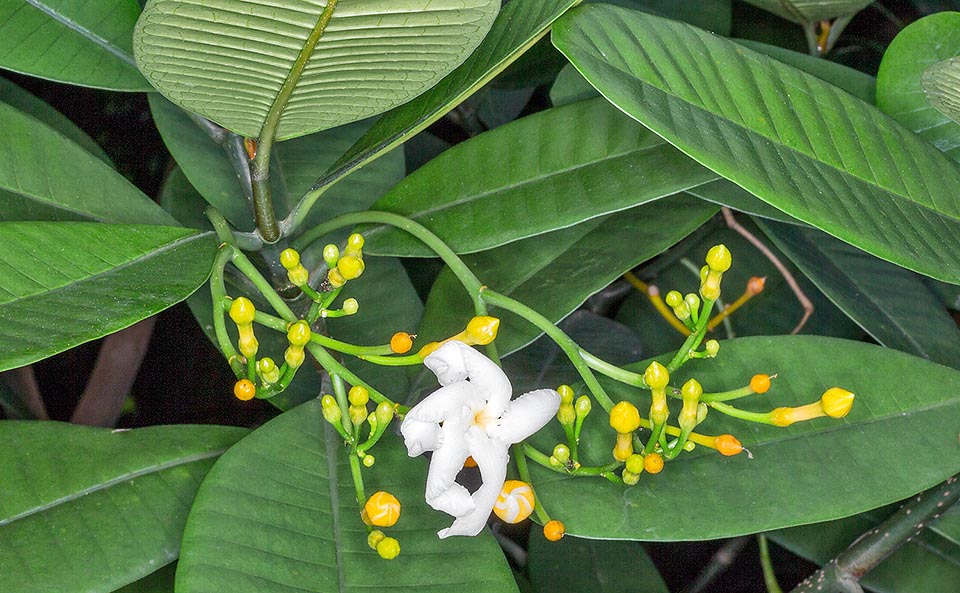Family : Apocynaceae

Text © Pietro Puccio

English translation by Mario Beltramini
The species is native to Myanmar, Peninsular Malaysia and Sri Lanka, where it lives in the humid forests between the 600 and the 1500 m of altitude.
The genus is honoured to the German physician and botanist Jakob Theodor Müller von Bergzabern (ca. 1520-1590), Tabernaemontanus being the Latinized name of Bergzabern; the specific name comes from the Greek “διχότομος” (dichotomos) = cut, divided in two, with reference to the inflorescences.
Common names: Eve’s apple, forbidden fruit, milk wood tree (English); kunnampala (Malayalam); pilikarbir (Punjabi); divi kaduru, kaduru (Singalese); kandalaippalai, kattalaripalai (Tamil).
The Tabernaemontana dichotoma Roxb. ex Wall. (1829) is a shrub or a small evergreen tree, usually 3-5 m tall, with a diameter if the trunk up to about 30 cm, even if in the wild are found old specimens up to 20 m tall, with milky irritating sap. The leaves, on a short petiole, are simple, opposite, oblong-elliptic with entire margin and obtuse apex, 8-22 cm long and 3-7 cm broad, coriaceous, of glossy intense green colour above and parallel lateral veins almost perpendicular to the central one. Cymose inflorescences at the axil of the upper leaves bearing numerous pleasantly scented flowers with hypocraterimorphous corolla, of about 4 cm of diameter, with 5 oblong-falcate lobes of white colour with yellow centre. The fruits are ovoid hanging follicles, usually coupled, 3,5-7 cm long and of 3-5 cm of diameter, with a lateral depression, orange when ripe, containing numerous oblong seeds surrounded by a pulp of crimson colour.
It reproduces by seed, in draining, light, organic loam, maintained humid, but without stagnations, at the temperature of 25-28 °C, by cutting, with bottom heat and high ambient humidity, and by layering.

Native to the Penisular Malaysia, Myanmar ans Sri Lanla forests, the Tabernaemontana dichotoma is a small tree with odd ovoid orange fruits, usually paired, with a lateral depression that makes them look as snapped and seeds surrounded by crimson pulp. The Portuguese who discovered it in Ceylon identified this island as the earthly Paradise and the plant as the tree of life. Actually all parts of the tree are poisonous but some alkaloids have important medicinal virtues © Giuseppe Mazza
Species of considerable ornamental interest due to the foliage and the pleasantly scented flowers, cultivable in the tropical and humid subtropical climate regions, not bearing temperatures under the +10 °C if not for a short time. Ite requires light, draining soils, rich of organic substance, maintained almost constantly humid, a slightly shaded position and high ambient humidity. Useful are periodical prunings for a more compact appearance and to stimulate the blooming. Cultivable also in pot, with the aforementioned precautions, in luminous ambient with lowest winter temperatures not under the 15 °C, with regular waterings during the vegetative period, more spaced in winter, but without ever allowing the substratum to dry up completely, and fertilizations, in spring summer, with hydrosoluble fertilizers, with microelements, at half the dosage suggested by the producer.
The Portuguese, first Europeans to reach Sri Lanka island, identified it as the place of the earth Paradise and the species as the tree of life, legend present also in other religions, hence some common names, due to the shape of the fruits that seem partially snapped.
All parts of the plant are extremely poisonous. Laboratory studies have evidenced the presence in various parts of the plant, in particular in the bark and seeds extracts, of indolic alkaloids with hypotensive and relaxing effects in the musculature, of possible interest in the official pharmacopoeia.
Synonyms: Tabernaemontana laurifolia Ker Gawl. (1823); Tabernaemontana dichotoma Roxb. (1824); Rejoua dichotoma (Roxb. ex Wall.) Gamble (1923); Cerbera dichotoma Lodd. (1829); Ervatamia dichotoma (Roxb. ex Wall.) Burkill (1935); Pagiantha dichotoma (Roxb. ex Wall.) Markgr. (1935); Tanghinia dichotoma. G.Don (1839)
→ To appreciate the biodiversity within the APOCYNACEAE family please click here.
